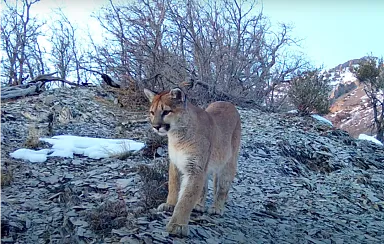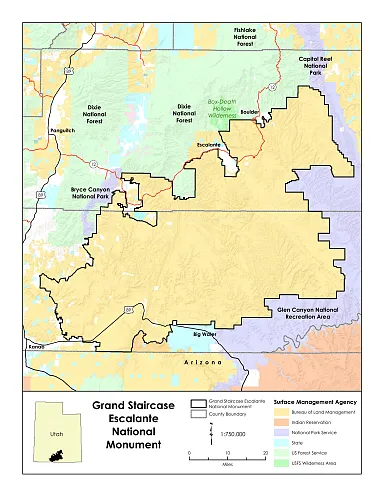
Uncovering the Secrets of Southern Utah’s Mountain Lions:
The GSE Cougar Project
- Author: Joshua Lisbon & Zara McDonald
- Publication Date: July 29, 2025
- Related Project: Grand Staircase-Escalante Cougar Project
- Focus Species: Puma concolor (Mountain Lion)
Hidden among the cliffs and canyons of Southern Utah’s Grand Staircase-Escalante National Monument (GSENM), mountain lions roam quietly through a remote and rugged landscape. But despite their vital ecological role, we know remarkably little about them—how many exist, how they interact, or how year-round hunting pressures are impacting their survival.
That’s why the GSE Cougar Project launched in 2024: to shine a light on the lives of cougars in GSENM through a long-term, noninvasive study that blends science, storytelling, and education.
With the recent designation of the Mojave to Moab Wildlife Corridor, this is a critical moment. As habitat connectivity improves across Utah’s desert landscapes, we need better data to inform how wildlife—especially apex carnivores—are surviving, adapting, and contributing to ecological balance.
A New Approach to Understanding Cougars
Unlike traditional studies that rely on GPS collars and animal capture, the GSE Cougar Project uses noninvasive genetic mark-recapture methods, collecting hair and scat samples from feeding and bedding sites. These samples are analyzed to identify individuals, assess relatedness, and estimate kitten survival rates—all without ever touching the animals.
Camera traps complement the genetic data and allow researchers to observe behavior and social interactions. The footage also serves another purpose: it will form the basis of a documentary film, capturing the lives of individual cougars and their families as they unfold across seasons.
Early findings from similar work suggest cougars are more socially complex than once believed—sometimes sharing food and space with unrelated individuals, an extraordinary behavior among large carnivores. The project seeks to uncover what drives this social flexibility, and how these relationships influence survival and territory use.
Core Research Questions
- How many mountain lions live in GSENM?
- What is the survival rate of kittens?
- What habitats and prey do they prefer?
- How socially tolerant are these cougars?
- Do unrelated individuals share resources?
- How does year-round hunting affect population health?
Why It Matters:
A Fragile Balance
Utah currently permits year-round hunting and trapping of cougars, with limited protections for kittens and nursing mothers. Without accurate data on population size and reproduction rates, it’s impossible to assess whether current harvest levels are sustainable—or if they are leading to long-term population decline.
Cougars are keystone species whose presence influences prey populations and maintains ecosystem health. Yet they are often misunderstood and persecuted, particularly in regions where they are seen as threats to livestock or recreation. This project aims to shift that narrative—through science-backed conservation and public engagement.

Education, Outreach, and Coexistence
Beyond data collection, community engagement is a cornerstone of the GSE Cougar Project. The team regularly hosts public talks, school presentations, and will soon launch virtual learning sessions in partnership with Inspired Classroom, reaching thousands of students across the country.
The message is clear: coexistence is possible, but it begins with understanding.
Project Partners
Rocky Mountain Research Station (RMRS) – Genetic and ecological analysis
Grand Staircase Escalante Partners (GSEP) – Conservation collaboration
Bureau of Land Management (BLM) – Regulatory and land management support
Utah Mountain Lion Conservation – GIS, camera trapping, and outreach expertise
Inspired Classroom – Development of K–12 curriculum and virtual learning
Be Part of the Story
Cougars are often called “ghost cats” for their elusive nature—but thanks to the GSE Cougar Project, their stories are coming to life. Join us in this journey to protect one of the West’s most iconic and misunderstood predators.
- Follow along for research updates, film previews, classroom resources, and ways to support the project.
- Spread the word—because protecting mountain lions means protecting the wild heart of Utah.
Do You Have 2-4 Hours A Month To Preserve Your Local Ecosystem?
Our volunteers are the driving force behind making true change in ecosystem health and wild cat conservation. Some like to volunteer in the field, others help us maintain our online presence, and some work with events. With just a few hours a month, you can make a difference, too.
Make A Difference Right Now
As a 501(c)3 nonprofit, our work is only possible because of generous donors like you.
More than 90% of your donation will go directly to our groundbreaking research, outreach, and education programs.
This is where true change starts. If you’d like to be a part of it, make a donation to Felidae Conservation Fund today:
Or,
